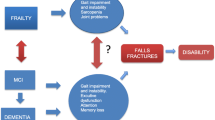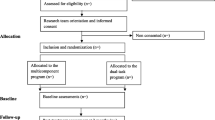Abstract
Background and aims: Home-based exercise is a viable solution for frail elderly individuals with difficulties in reaching exercise facilities outside home. The aim of this study was to determine the effects of a home-based video exercise program on physiological performance, functional capacity and health-related quality of life. Methods: Community-dwelling frail women ≥75 yrs, receiving public home care, were randomized into a training group (n=30) and a control group (n=31). Participants exercised for 26 minutes, three times per week for five months. Both groups received a bi-weekly telephone call. The effect of intervention was evaluated by the physical performance test, mobility-tiredness score, maximal isometric handgrip and biceps strength, lower limb explosive power, repeated chair rise (5 times), 10-m maximal walking-speed, semi-tandem balance, and health-related quality of life, as measured by EQ-5D and self-rated health. Results: Twenty-five participants (83%) in the training group and 28 (90%) in the control group completed the project. Adherence to the training protocol was on average 89.2%. At follow-up, between-group analysis revealed a significant difference only in EQ-5D (valued by time-trade-off tariffs), resulting from a significant decrease observed in the control group and a trend towards an increase in the training group (p=0.082). Significant within-group improvements, ranging from 8–35%, were also observed for the physical performance test, mobility-tiredness score, handgrip, biceps strength, chair rise, and 10-m maximal walking-speed in the training group, and for walking-speed and self-rated health in the control group. Conclusions: These results suggest that home-based training for frail older women using an exercise video induces lasting health-related quality-of-life (EQ-5D). In addition, a tendency towards improvements in physiological performance and functional capacity was observed.
Similar content being viewed by others
References
Andersen-Ranberg K, Christensen K, Jeune B, Skytthe A, Vasegaard L, Vaupel JW. Declining physical abilities with age: a cross-sectional study of older twins and centenarians in Denmark. Age Ageing 1999; 28: 373–7.
Puggaard L. Age-related decline in maximal oxygen capacity: consequences for performance of everyday activities. J Am Geriatr Soc 2005; 53: 546–7.
Schroll M. Physical activity in an ageing population. Scand J Med Sci Sports 2003; 13: 63–9.
Salkeld G, Cameron ID, Cumming RG, et al. Quality of life related to fear of falling and hip fracture in older women: a time trade off study. BMJ 2000; 320: 341–5.
Avlund K, Due P, Holstein BE, Heikkinen RL, Berg S. Changes in social relations in old age. Are they influenced by functional ability? Aging Clin Exp Res 2002; 14: 56–64.
World Health Organisation. Active Ageing. A Policy Framework. Second United Nations World Assembly on Ageing, Madrid, Spain 2002. Available at http://whqlibdoc.who.int/hq/2002/WHO_NMH_NPH_02.8.pdf. Accessed 2008 Oct 1.
Singh MA. Exercise comes of age: rationale and recommendations for a geriatric exercise prescription. J Gerontol A Biol Sci Med Sci 2002; 57: M262–82.
Spirduso WW, Cronin DL. Exercise dose-response effects on quality of life and independent living in older adults. Med Sci Sports Exerc 2001; 33: S598–608.
Pronk NP, Goodman MJ, O’Connor PJ, Martinson BC. Relationship between modifiable health risks and short-term health care charges. JAMA 1999; 282: 2235–9.
Chin APM, van Poppel MN, Twisk JW, van Mechelen W. Once a week not enough, twice a week not feasible? A randomised controlled exercise trial in long-term care facilities [IS-RCTN87177281]. Patient Educ Couns 2006; 63: 205–14.
Campbell AJ, Robertson MC, Gardner MM, Norton RN, Tilyard MW, Buchner DM. Randomised controlled trial of a general practice programme of home based exercise to prevent falls in elderly women. BMJ 1997; 315: 1065–9.
Robertson MC, Devlin N, Gardner MM, Campbell AJ. Effectiveness and economic evaluation of a nurse delivered home exercise programme to prevent falls. 1: Randomised controlled trial. BMJ 2001; 322: 697–701.
Atienza AA. Home-based physical activity programs for middle-aged and older adults: summary of empirical research. J Aging Phys Activity 2001; 9: S38–58.
Ashmead JC, Bocksnick JG. Home-based circuit training for elderly women: an exploratory investigation. Activities 2002; 47–60.
Jette AM, Lachman M, Giorgetti MM, et al. Exercise — it’s never too late: the strong-for-life program. Am J Public Health 1999; 89: 66–72.
Jette AM, Harris BA, Sleeper L, et al. A home-based exercise program for nondisabled older adults. J Am Geriatr Soc 1996; 44: 644–9.
Foldvari M, Clark M, Laviolette LC, et al. Association of muscle power with functional status in community-dwelling elderly women. J Gerontol A Biol Sci Med Sci 2000; 55: M192–9.
Rantanen T, Avela J. Leg extension power and walking speed in very old people living independently. J Gerontol A Biol Sci Med Sci 1997; 52: M225–31.
Bassey EJ, Short AH. A new method for measuring power output in a single leg extension: feasibility, reliability and validity. Eur J Appl Physiol Occup Physiol 1990; 60: 385–90.
Folstein MF, Folstein SE, McHugh PR. “Mini-mental state”. A practical method for grading the cognitive state of patients for the clinician. J Psychiatr Res 1975; 12: 189–98.
Rantanen T, Masaki K, Foley D, Izmirlian G, White L, Guralnik JM. Grip strength changes over 27 yr in Japanese-American men. J Appl Physiol 1998; 85: 2047–53.
Puggaard L. Effects of training on functional performance in 65, 75 and 85 year-old women: experiences deriving from community based studies in Odense, Denmark. Scand J Med Sci Sports 2003; 13: 70–6.
Guralnik JM, Simonsick EM, Ferrucci L, et al. A short physical performance battery assessing lower extremity function: association with self-reported disability and prediction of mortality and nursing home admission. J Gerontol 1994; 49: M85–94.
Worm CH, Vad E, Puggaard L, Stovring H, Lauritsen J, Kragstrup J. Effects of a multicomponent exercise program on functional ability in community-dwelling, frail older adults. J Aging Phys Act 2001; 9: 414–24.
Reuben DB, Siu AL. An objective measure of physical function of elderly outpatients. The Physical Performance Test. J Am Geriatr Soc 1990; 38: 1105–12.
Reuben DB, Siu AL, Kimpau S. The predictive validity of self-report and performance-based measures of function and health. J Gerontol 1992; 47: M106–10.
Avlund K, Kreiner S, Schultz LK. Functional ability scales for the elderly: a validation study. Eur J Public Health 1996; 6: 35–42.
Vass M, Avlund K, Hendriksen C, Andersen CK, Keiding N. Preventive home visits to older people in Denmark: methodology of a randomized controlled study. Aging Clin Exp Res 2002; 14: 509–15.
Brooks R. EuroQol: the current state of play. Health Policy 1996; 37: 53–72.
Møller Pedersen K, Wittrup-Jensen K, Brooks R, Gudex C. Valuation of health. The theory of quality adjusted life years and a Danish application (in Danish). Odense: University of Southern Denmark Press; 2003.
Borg G. Perceived exertion as an indicator of somatic stress. Scand J Rehabil Med 1970; 2: 92–8.
Bouchet C, Guillemin F, Briancon S. Nonspecific effects in longitudinal studies: impact on quality of life measures. J Clin Epidemiol 1996; 49: 15–20.
Puggaard L, Larsen JB, Stovring H, Jeune B. Maximal oxygen uptake, muscle strength and walking speed in 85-year-old women: effects of increased physical activity. Aging Clin Exp Res 2000; 12: 180–9.
Bassey EJ. Benefits of exercise in the elderly. In: Isaacs B, ed. Recent Advantages in Geriatric Medicine. Churchill Livingstone, 1985: 91–112.
Hogan DB, MacKnight C, Bergman H. Models, definitions, and criteria of frailty. Aging Clin Exp Res 2003; 15: 1–29.
Sonn U, Frandin K, Grimby G. Instrumental activities of daily living related to impairments and functional limitations in 70-year-olds and changes between 70 and 76 years of age. Scand J Rehabil Med 1995; 27: 119–28.
Bassey EJ, Fiatarone MA, O’Neill EF, Kelly M, Evans WJ, Lipsitz LA. Leg extensor power and functional performance in very old men and women. Clin Sci (Lond) 1992; 82: 321–7.
Vestergaard S, Andersen CK, Korsholm L, Puggaard L. Exercise intervention of 65+-year-old men and women: functional ability and health care costs. Aging Clin Exp Res 2006; 18: 227–34.
Gold MR, Patrick DL, Torrance GW, et al. Identifying and valuing outcomes. In Gold MR, Siegel JE, Russell LB et al, eds. Cost-Effectiveness in Health and Medicine. Oxford University Press, 1996: 82–134.
Rissanen P, Sogaard J, Sintonen H. Do QOL instruments agree? A comparison of the 15D (Health-Related Quality of Life) and NHP (Nottingham Health Profile) in hip and knee replacements. Int J Technol Assess Health Care 2000; 16: 696–705.
Helbostad JL, Sletvold O, Moe-Nilssen R. Effects of home exercises and group training on functional abilities in home-dwelling older persons with mobility and balance problems. A randomized study. Aging Clin Exp Res 2004; 16: 113–21.
Helbostad JL, Sletvold O, Moe-Nilssen R. Home training with and without additional group training in physically frail old people living at home: effect on health-related quality of life and ambulation. Clin Rehabil 2004; 18: 498–508.
Heritier SR, Gebski VJ, Keech AC. Inclusion of patients in clinical trial analysis: the intention-to-treat principle. Med J Aust 2003; 179: 438–40.
Hollis S, Campbell F. What is meant by intention to treat analysis? Survey of published randomised controlled trials. BMJ 1999; 319: 670–4.
Author information
Authors and Affiliations
Corresponding author
Rights and permissions
About this article
Cite this article
Vestergaard, S., Kronborg, C. & Puggaard, L. Home-based video exercise intervention for community-dwelling frail older women: a randomized controlled trial. Aging Clin Exp Res 20, 479–486 (2008). https://doi.org/10.1007/BF03325155
Received:
Accepted:
Published:
Issue Date:
DOI: https://doi.org/10.1007/BF03325155




